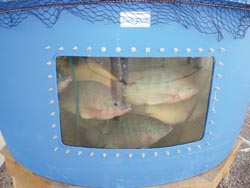 For about $3,000, you can buy an aquaponic system that'll let you raise fresh fish and vegetables year-round whether you are in Florida or Minnesota. Nelson and Pade, Inc. can set you up with a backyard system or a commercial-size operation.
For about $3,000, you can buy an aquaponic system that'll let you raise fresh fish and vegetables year-round whether you are in Florida or Minnesota. Nelson and Pade, Inc. can set you up with a backyard system or a commercial-size operation.
Owners Rebecca Nelson and John Pade sell turnkey systems that are designed to install in any greenhouse.
"It's a loop," Nelson explains. "Fish are in tanks stocked fairly densely, and their water goes through filter tanks and through plant beds before going back to the fish."
The plants' roots draw nutrients from the fish water, and fish get clean water that's aerated, which benefits the fish, plants and good bacteria. The only "additive" is fish food, which contains healthy grains, minerals and vitamins.
Nelson notes that she and Pade got their start in hydroponics, growing vegetables in water. They liked the system, but didn't like using manmade fertilizers. They were attracted to aquaponics because it uses natural fertilizer from the fish. They started experimenting in the early 90?s, and by 1997, they were putting out a quarterly Aquaponics Journal, and establishing themselves as leaders in the field. They make how-to videos, have written a book, and regularly offer three-day workshops for hands-on aquaponics training. They also have set up an accredited class with the University of Wisconsin.
With popular interest in fresh, local food, aquaponics offers a viable option. A family raising food for their own needs might raise hybrid bluegill fish, crappie or bass and an assortment of veggies from radishes to sweet corn. The $3,000 F-5 ?Food Factory? system produces up to 110 lbs. of fish per year and 900 to 1,440 heads of lettuce per year with a 110-gal. fish tank and two 3 by 5-ft. beds. The vegetable growing setup has 90 plant sites that can be planted with any type of seedlings.
That ability to have a continuous supply is important for commercial growers who typically grow tilapia and lettuce. Systems range from $46,000 to $82,500.
Nelson says the company's bestseller is the Farm Market system, which grows enough food for home use and to sell at farmers markets. There are two options at $20,000 and $30,000.
A new system, the Living Food Bank, has been set up in Haiti to provide fresh food at a local mission. Nelson and Pade are excited about growing that part of the business to help feed people throughout the world.
Nelson says as more and more people get into aquaponics, it will become common to find produce and fish grown by aquaponics at grocery stores, which is good for consumers. There are many benefits for growers too.
"It's controlled environment agriculture and works in any climate," she says. Though it?s water-based, the system uses less water than crops grown in soil. It takes 24 gal. of water to grow lettuce in soil, for example, and only 3 or 4 gal. when grown in an aquaponic system. Without soil, there are no soil-borne diseases.
"We sell the whole system, not parts," Nelson adds. "People have the most success if they aren?t reinventing the wheel."
Systems have been sold to many countries, and there has been a growing interest in the larger commercial systems, Nelson says.
1-800-834-9665
They Grow Fish And Veggies Together
FARM SHOW Magazine » They Grow Fish And Veggies Together
They Grow Fish And Veggies Together
